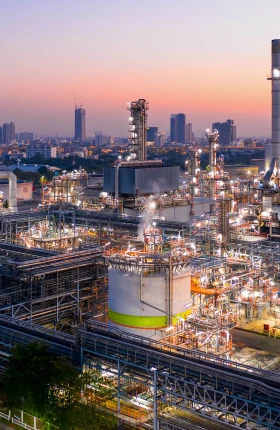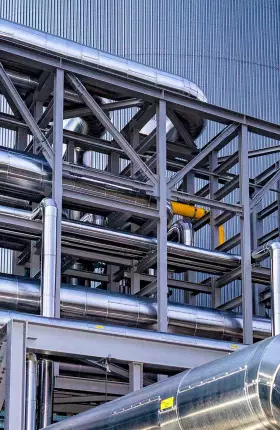Plunging global demand in the wake of COVID-19 has led to an oil glut—and swelling demand for storage. Owners of oil terminals are all smiles, but the good times cannot last forever. Oil markets’ current steep contango (that is, spot prices well below futures prices), which has been a particularly strong driver of demand, will inevitably give way to backwardation (spot prices trading higher than futures prices).
Nevertheless, we expect there to be attractive investment opportunities in this arena again soon. To position themselves optimally, investors should use the current window of time to perform strategic due diligence on their targeted investments, making sure they fully grasp the short- and long-term dynamics of their chosen product and geographic markets as well as the business models of the facilities they are eyeing.
Current asset owners, for their part, should use the time to exploit all available value- maximization levers to ensure that they have the financial resilience necessary to weather the inevitable return of more challenging days.
An Emerging Asset Class in Its Own Right
Investments in liquid bulk storage can prove extremely lucrative. They can also add a valuable degree of portfolio diversification. Indeed, we think storage terminals, which behave differently from many other investments, should be viewed as a unique asset class.
Storage serves a critical role in both the oil and chemical value chains. It provides connections between key links in the chains—namely, production, refining, and distribution—and serves as a repository for surplus and buffer inventory. It also has several characteristics that are exceptionally attractive to investors, including a relatively simple revenue model and high profit margins (EBITDA margins above 50% across the full contango-backwardation cycle are common). In addition, terminal owners, unlike their customers, have limited direct exposure to commodity-price volatility (because they do not own the product being stored).
After limited activity (an average of two deals a year) from 2006 through 2012, M&A transactions in the storage arena have picked up significantly, averaging nine deals a year. The majority of these deals have focused on Europe-based assets, with the area surrounding the Amsterdam-Rotterdam-Antwerp (ARA) ports (Europe’s largest port area and one of the world’s largest liquid bulk hubs) a particularly hot market. (See Exhibit 1.)
Financial players have been increasingly active buyers in this space, snapping up offerings that have come to market as oil and gas majors and Vopak, the world’s largest independent storage provider, have continued to divest themselves of non-core terminals. For example, these players, which had zero stake in the ARA region about a decade ago, now own roughly half of capacity. (See Exhibit 2.) For such investors, storage facilities’ business and investment profiles are particularly enticing compared with holdings from other industries that they would typically have in their portfolios.
Investors in this arena generally comprise two different types of players. Private-equity investors have a higher risk appetite and are hoping to earn healthy returns, primarily through multiple expansion. (However, note that multiple expansion seemed a surer bet several years ago than today. Multiples reached 15 or even 20 times EBITDA a few years ago; more recent transactions have hovered around 10 times EBITDA.) Infrastructure-focused investors are seeking stable returns and/or to manage the facilities for cash-generation purposes. The limited direct exposure to commodity prices and a business model that translates into recurring revenue makes this asset class attractive to them.
Limited direct exposure to commodity prices and a business model that translates into recurring revenue makes this asset class attractive to investors.
The growing presence of financial investors in this space has clear implications. One of the most noteworthy is a sharp rise of financial firepower in the market, much of which has been aimed at building broader platforms that can support longer-term, sustainable growth. Koole Terminals’ recent acquisition of Odfjell Terminals Rotterdam is an example of this dynamic. A potential future wave of transactions initiated by financial investors is likely to be geared toward consolidating storage capacity in selected ports.
Today’s Market: Near-Term Rewards but Grounds for Caution
The oil market’s recent supply-demand gyrations have pushed it into a state of pronounced contango, with futures priced considerably higher than spot prices. This has created a strong incentive for traders to pursue a cash-and-carry strategy—and thus robust demand for oil storage. Earlier this year, tanks were filling at unprecedented rates, a pace that would have taken up almost all available capacity within a few months. For tank owners, this has translated into the combination of high utilization rates and storage fees for short-term contracts as well as the renewal of longer-term leases.
But this confluence of forces can change, especially in the medium term, materially altering the risk profile of storage ownership. A weak and/or slow-moving economic recovery from the damage wrought by COVID-19 could substantially alter oil’s current supply-demand dynamic—so-called “peak oil,” or the hypothetical date at which production of the resource reaches its apex, might already have been reached in 2019, for example. Accelerated adoption of electric vehicles and green energy sources, a secular shift in the workplace toward work-from-home arrangements, or an industry shakeout could do the same.
Given these risks, we would urge investors to refrain from extrapolating and assuming the present good times for storage will last forever. We would also urge investors to distinguish along multiple dimensions between assets. Different product-market dynamics, and different locations and business models among facilities, make the likely utilization rates of facilities highly variable. Investors need to recognize this and make well-informed bets.
The Need to Differentiate
A major consideration for potential investors is the stability of a terminal’s cash flows. This can be influenced by several factors. One is location. On balance, facilities in Europe face the greatest risk of cash-flow instability in the near to intermediate term. This is due to a confluence of trends, including declining oil-product consumption and the relocation of chemical production to regions, such as the US and Asia, with price-advantaged feedstock. (Nevertheless, Europe will also provide some of the best opportunities for investors in terms of new assets coming to market.)
Investors should also consider the scale of the market served by a terminal and the characteristics of the trade flows that pass by it. Facilities in ARA, a global hub, are likely to have a more stable position in servicing global commodity flows than facilities in, for instance, the Baltic Corridor, which is suffering from reduced Russian exports.
Structural challenges in product markets will also affect cash-flow stability. In Europe, for example, cash flows for terminals that store jet fuel could be hurt by a slower-than-expected recovery for aviation; those that store bunker fuel are suffering from the effects of IMO 2020 (the International Maritime Organization’s mandate regarding the allowable levels of sulfur in shipping fuel) if they are unable to tap into the greater demand for lower-sulfur products.
European terminals that store gasoline or diesel fuel are exposed to the risk of declining demand for road fuels due to climate policy, improved engine efficiency, and accelerating adoption of electric vehicles. Although stricter climate regulation will increase demand for the blending of biofuels, and hence the need for tank storage (where much of the blending would take place), ultimately we expect the forces of fuel switching and increased adoption of EVs to reduce European demand for gasoline for light vehicles by 5% to 15%, and diesel fuel by 30% to 40% over the next ten years. This will undoubtedly be felt by storage providers serving distribution markets.
Storage providers that serve export markets or are integrated in refinery supply chains, meanwhile, are likely to be negatively impacted by shrinking regional demand for oil products. But the effects are likely to be confined geographically. Refined products are globally traded—for example, European refineries currently export about 30% of their products—and global demand is still growing. In the next few years, we expect European refineries to increase their volume of exports rather than close down, which will increase regional demand for storage. In the longer term, European refinery capacity may ultimately rationalize to a degree, with some terminals closing down. But the effects on storage are still likely to be highly localized.
A terminal’s business model is a critical determinant of cash-flow stability.
This brings us to the other critical determinant of cash-flow stability—a terminal’s business model. (See Exhibit 3.) We distinguish between five models. Arbitrage models are based on holding products whose future value (secured by contract) exceeds their present value. Export hub (also called “make bulk”) models are centered on the management (and sometimes preparation, including blending) and distribution of products intended for export. Inbound distribution (also called “break bulk”) models are based on the processing (including adjustments to product specifications) of imported products to facilitate their subsequent distribution to specific markets. Manufacturing supply chain models focus on the management of inputs and outputs of an energy or chemicals manufacturer—the terminal thus assumes an integral part of the producer’s supply chain. Finally, strategic storage models are based on holding strategic reserves for governments.
Each model has its strengths; each also has risks from a cash-flow stability perspective. For example, an arbitrage model risks backwardation (that is, spot prices being higher than futures prices) and its impact on utilization rates, while a manufacturing supply chain model may be hurt by deterioration of the customer’s competitive standing within the industry.
By gaining a thorough understanding of the risks and opportunities afforded by an asset’s location, targeted product market, and business model, investors can determine a reasonable multiple for the asset. This can unearth bargains and, conversely, substantially reduce the risk of overpayment.
Value-Creation Levers for Owners
New owners can deploy five highly effective levers to increase an asset’s performance and free cash flow. (See Exhibit 4.) The first is to emphasize revenue maximization rather than tank-utilization rate. This runs counter to the traditional practice of most terminal owners, for whom utilization rate is the core KPI. But there are times when having full utilization is a liability, as it prevents an owner from seizing the chance to opportunistically store fuel that offers a higher rate.
Leveraging the latest artificial intelligence–powered commodity-flow models to track and trace products in real time across the main trade routes will help owners better understand pending demand for storage and identify upcoming opportunities. Revenue maximization can also be aided by the integration of advanced analytics into business planning.
Leveraging the latest AI-powered models will help owners better understand pending demand for storage and identify upcoming opportunities.
The second lever is to automate and centralize operations where possible. Opportunities to apply technology to operations—for example, automating readings and tank inspections—should be seized. This will lower operational expenditures and increase financial resilience, easing the sting of periods of low tank utilization. Centralization of operations—for instance, the creation of a shared control room covering multiple terminals—should also be considered, as it too can lower costs and support decision making. Enhanced operational efficiency will also support better customer service delivery, a key success factor for terminals.
The third lever is to optimize maintenance spending. Smart planning of tank inspections can minimize disruptions in operations. The use of predictive maintenance algorithms, which are already being deployed by oil and gas players and companies in other processing industries, can help ensure that maintenance efforts are preventive rather than reactive. They can also boost flexibility in maintenance and lower overall maintenance costs.
The fourth lever is to improve investment discipline in the evaluation of capital expenditures. Many assets will be coming to market in the near to medium term, offering a variety of ideas for expansion. Properly vetting those ideas will be critical. The use of stage gates in decision making can enable better choices (operators can leverage best practices from other capital-intensive industries), as can the institution of an independent review board that includes representation from financial shareholders. Taking a portfolio view of projects rather than assessing each in isolation is critical for maximizing value creation.
The final lever is to review the business’s cash-management procedures. Many companies in the storage arena have not made this activity a priority. As a result, they can often score quick wins by improving the collection process, reviewing and adjusting clients’ payment terms, and better managing working capital.
Investment in digital capabilities can help ensure that these levers, especially the first three, deliver to their fullest potential. Operators can draw on lessons learned by traders and by oil and gas as well as chemicals companies that are farther along the digitalization path. They may also be able to leverage existing tools in the market. In addition, operators should leverage scale where possible to reap financial benefits that create competitive advantage—for example, sufficient assets to invest early in AI and integrated control rooms.
An overarching decision for operators—one they should make before launching a full performance improvement plan—is how they plan to make money from the asset. Will they operate it for cash-generation purposes? This could well become the dominant strategy in the next few years, as the outlook for core products for storage (such as gasoline, diesel fuel, and bunker fuel) could change materially. Will they run it with the goal of boosting its multiple over the next several years—for instance, by lowering the asset’s business risk through product diversification or strengthening the client relationship by locking in long-term lease arrangements—and selling it at a profit? Or will they view it as a potential turnaround candidate—that is, a distressed asset that could be brought back on track and sold at its new, fully realized value?
Many opportunities to own oil-storage facilities are likely to present themselves in the short to medium term. This holds for mature markets in Europe in particular, but potentially attractive opportunities are also emerging in Latin America (driven largely by divestment programs by Petrobras and Pemex), Southeast Asia, and the Middle East (as both national and international oil companies seek partners for the operation of their non-core assets) as well. Smart investors who have done their homework and can separate the wheat from the chaff stand to do exceptionally well, securing assets that have immediate and/or longer-term value at quite reasonable prices. The time to prepare for this coming window of opportunity is now.













